Qihang Peng
DenseGrounding: Improving Dense Language-Vision Semantics for Ego-Centric 3D Visual Grounding
May 08, 2025Abstract:Enabling intelligent agents to comprehend and interact with 3D environments through natural language is crucial for advancing robotics and human-computer interaction. A fundamental task in this field is ego-centric 3D visual grounding, where agents locate target objects in real-world 3D spaces based on verbal descriptions. However, this task faces two significant challenges: (1) loss of fine-grained visual semantics due to sparse fusion of point clouds with ego-centric multi-view images, (2) limited textual semantic context due to arbitrary language descriptions. We propose DenseGrounding, a novel approach designed to address these issues by enhancing both visual and textual semantics. For visual features, we introduce the Hierarchical Scene Semantic Enhancer, which retains dense semantics by capturing fine-grained global scene features and facilitating cross-modal alignment. For text descriptions, we propose a Language Semantic Enhancer that leverages large language models to provide rich context and diverse language descriptions with additional context during model training. Extensive experiments show that DenseGrounding significantly outperforms existing methods in overall accuracy, with improvements of 5.81% and 7.56% when trained on the comprehensive full dataset and smaller mini subset, respectively, further advancing the SOTA in egocentric 3D visual grounding. Our method also achieves 1st place and receives the Innovation Award in the CVPR 2024 Autonomous Grand Challenge Multi-view 3D Visual Grounding Track, validating its effectiveness and robustness.
ProxyTransformation: Preshaping Point Cloud Manifold With Proxy Attention For 3D Visual Grounding
Feb 26, 2025Abstract:Embodied intelligence requires agents to interact with 3D environments in real time based on language instructions. A foundational task in this domain is ego-centric 3D visual grounding. However, the point clouds rendered from RGB-D images retain a large amount of redundant background data and inherent noise, both of which can interfere with the manifold structure of the target regions. Existing point cloud enhancement methods often require a tedious process to improve the manifold, which is not suitable for real-time tasks. We propose Proxy Transformation suitable for multimodal task to efficiently improve the point cloud manifold. Our method first leverages Deformable Point Clustering to identify the point cloud sub-manifolds in target regions. Then, we propose a Proxy Attention module that utilizes multimodal proxies to guide point cloud transformation. Built upon Proxy Attention, we design a submanifold transformation generation module where textual information globally guides translation vectors for different submanifolds, optimizing relative spatial relationships of target regions. Simultaneously, image information guides linear transformations within each submanifold, refining the local point cloud manifold of target regions. Extensive experiments demonstrate that Proxy Transformation significantly outperforms all existing methods, achieving an impressive improvement of 7.49% on easy targets and 4.60% on hard targets, while reducing the computational overhead of attention blocks by 40.6%. These results establish a new SOTA in ego-centric 3D visual grounding, showcasing the effectiveness and robustness of our approach.
Maximum Likelihood CFO Estimation for High-Mobility OFDM Systems: A Chinese Remainder Theorem Based Method
Dec 27, 2023Abstract:Orthogonal frequency division multiplexing (OFDM) is a widely adopted wireless communication technique but is sensitive to the carrier frequency offset (CFO). For high-mobility environments, severe Doppler shifts cause the CFO to extend well beyond the subcarrier spacing. Traditional algorithms generally estimate the integer and fractional parts of the CFO separately, which is time-consuming and requires high additional computations. To address these issues, this paper proposes a Chinese remainder theorem-based CFO Maximum Likelihood Estimation (CCMLE) approach for jointly estimating the integer and fractional parts. With CCMLE, the MLE of the CFO can be obtained directly from multiple estimates of sequences with varying lengths. This approach can achieve a wide estimation range up to the total number of subcarriers, without significant additional computations. Furthermore, we show that the CCMLE can approach the Cram$\acute{\text{e}}$r-Rao Bound (CRB), and give an analytic expression for the signal-to-noise ratio (SNR) threshold approaching the CRB, enabling an efficient waveform design. Accordingly, a parameter configuration guideline for the CCMLE is presented to achieve a better MSE performance and a lower SNR threshold. Finally, experiments show that our proposed method is highly consistent with the theoretical analysis and advantageous regarding estimated range and error performance compared to baselines.
Channel Capacity and Bounds In Mixed Gaussian-Impulsive Noise
Nov 15, 2023



Abstract:Communication systems suffer from the mixed noise consisting of both non-Gaussian impulsive noise (IN) and white Gaussian noise (WGN) in many practical applications. However, there is little literature about the channel capacity under mixed noise. In this paper, we prove the existence of the capacity under p-th moment constraint and show that there are only finite mass points in the capacity-achieving distribution. Moreover, we provide lower and upper capacity bounds with closed forms. It is shown that the lower bounds can degenerate to the well-known Shannon formula under special scenarios. In addition, the capacity for specific modulations and the corresponding lower bounds are discussed. Numerical results reveal that the capacity decreases when the impulsiveness of the mixed noise becomes dominant and the obtained capacity bounds are shown to be very tight.
Knowledge Graph Based Waveform Recommendation: A New Communication Waveform Design Paradigm
Jan 24, 2022



Abstract:Traditionally, a communication waveform is designed by experts based on communication theory and their experiences on a case-by-case basis, which is usually laborious and time-consuming. In this paper, we investigate the waveform design from a novel perspective and propose a new waveform design paradigm with the knowledge graph (KG)-based intelligent recommendation system. The proposed paradigm aims to improve the design efficiency by structural characterization and representations of existing waveforms and intelligently utilizing the knowledge learned from them. To achieve this goal, we first build a communication waveform knowledge graph (CWKG) with a first-order neighbor node, for which both structured semantic knowledge and numerical parameters of a waveform are integrated by representation learning. Based on the developed CWKG, we further propose an intelligent communication waveform recommendation system (CWRS) to generate waveform candidates. In the CWRS, an improved involution1D operator, which is channel-agnostic and space-specific, is introduced according to the characteristics of KG-based waveform representation for feature extraction, and the multi-head self-attention is adopted to weigh the influence of various components for feature fusion. Meanwhile, multilayer perceptron-based collaborative filtering is used to evaluate the matching degree between the requirement and the waveform candidate. Simulation results show that the proposed CWKG-based CWRS can automatically recommend waveform candidates with high reliability.
A Neural Network Detector for Spectrum Sensing under Uncertainties
Aug 06, 2019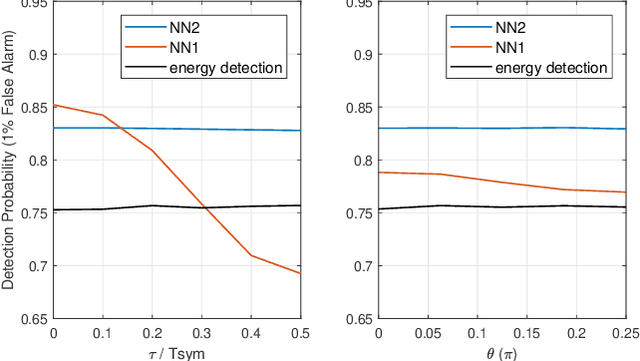
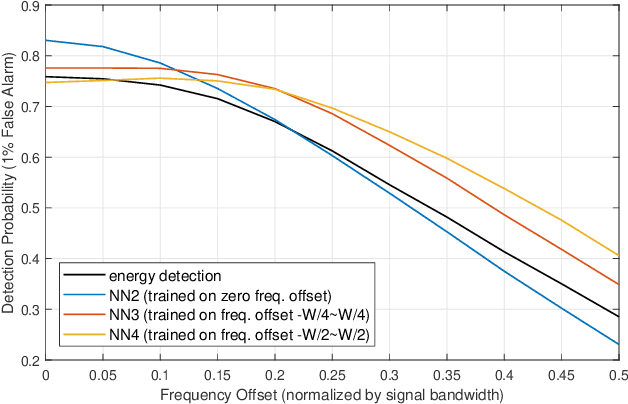
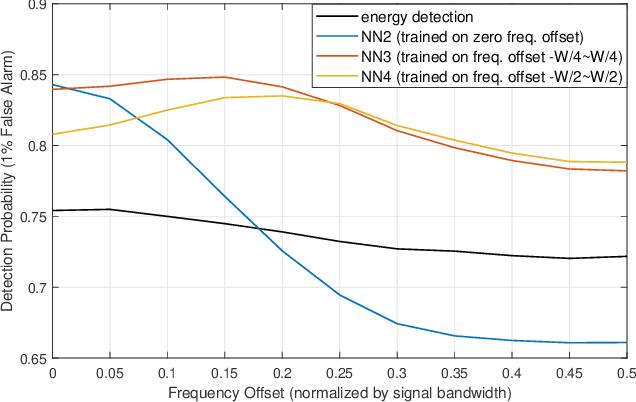
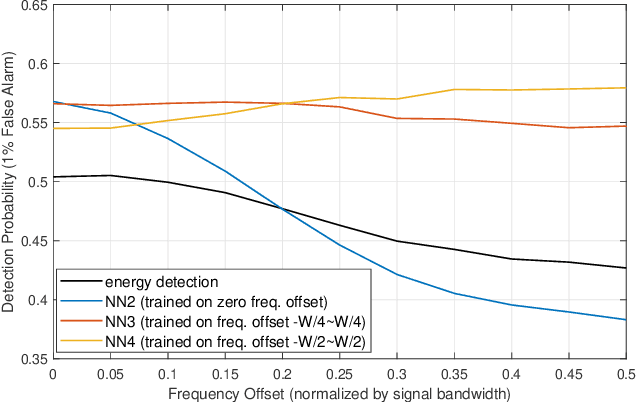
Abstract:Spectrum sensing is of critical importance in any cognitive radio system. When the primary user's signal has uncertain parameters, the likelihood ratio test, which is the theoretically optimal detector, generally has no closed-form expression. As a result, spectrum sensing under parameter uncertainty remains an open question, though many detectors exploiting specific features of a primary signal have been proposed and have achieved reasonably good performance. In this paper, a neural network is trained as a detector for modulated signals. The result shows by training on an appropriate dataset, the neural network gains robustness under uncertainties in system parameters including the carrier frequency offset, carrier phase offset, and symbol time offset. The result displays the neural network's potential in exploiting implicit and incomplete knowledge about the signal's structure.
Robust Deep Sensing Through Transfer Learning in Cognitive Radio
Aug 01, 2019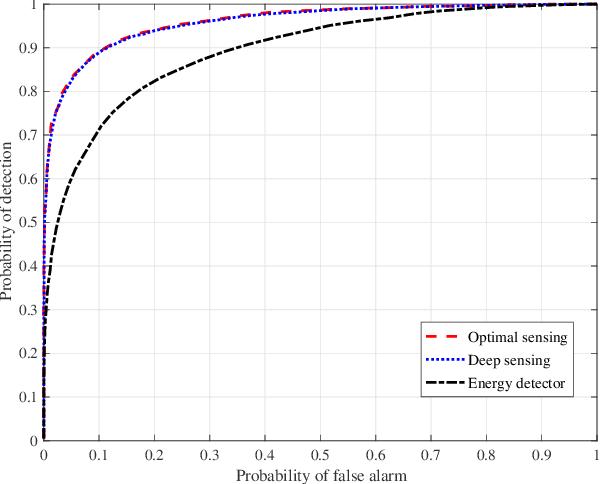
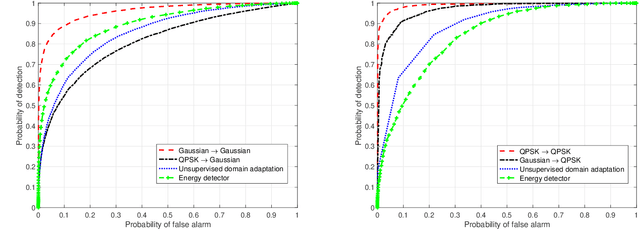
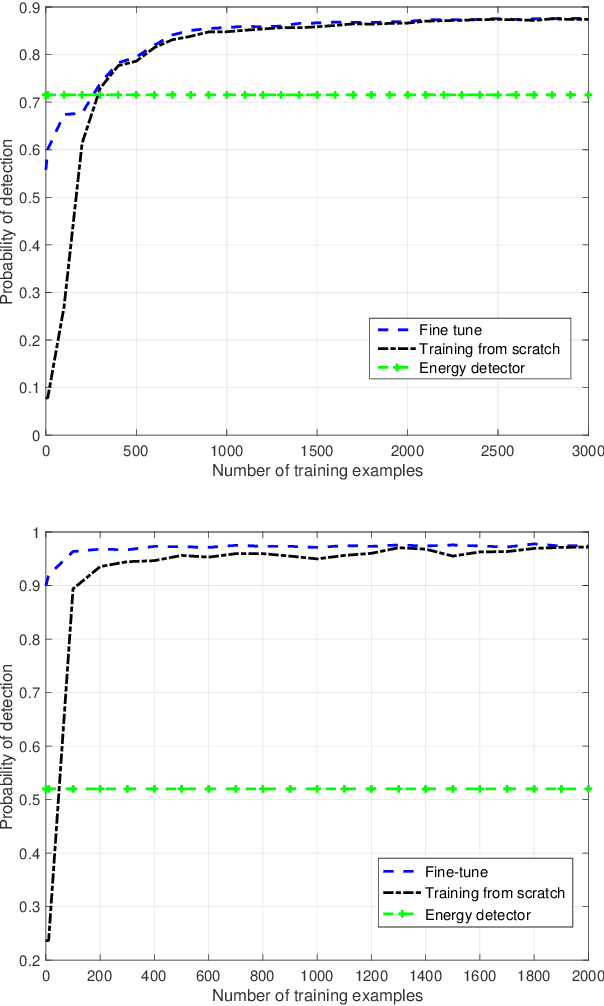
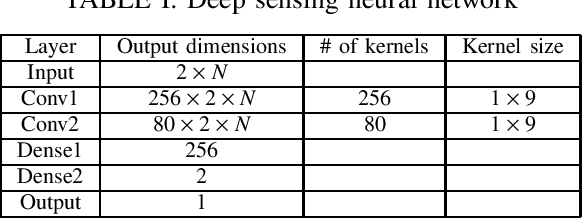
Abstract:We propose a robust spectrum sensing framework based on deep learning. The received signals at the secondary user's receiver are filtered, sampled and then directly fed into a convolutional neural network. Although this deep sensing is effective when operating in the same scenario as the collected training data, the sensing performance is degraded when it is applied in a different scenario with different wireless signals and propagation. We incorporate transfer learning into the framework to improve the robustness. Results validate the effectiveness as well as the robustness of the proposed deep spectrum sensing framework.
Comparison of Neural Network Architectures for Spectrum Sensing
Jul 15, 2019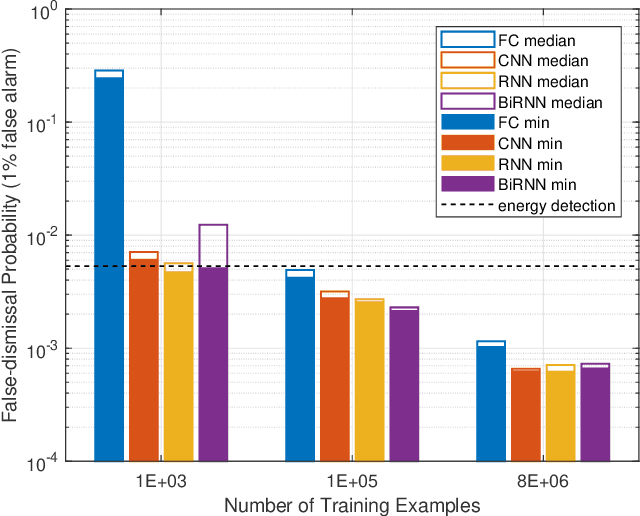
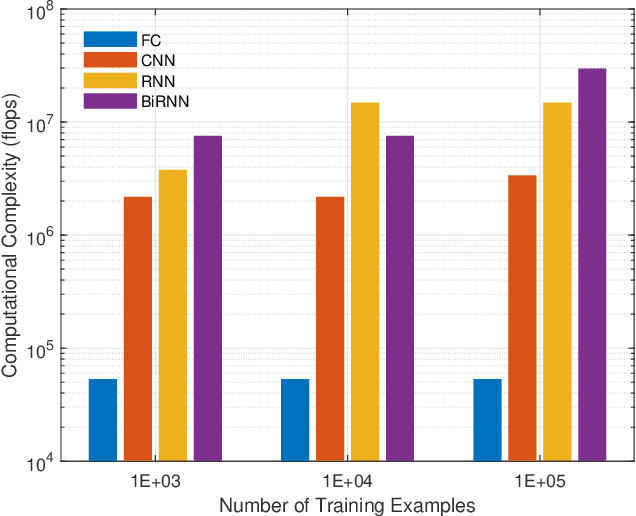
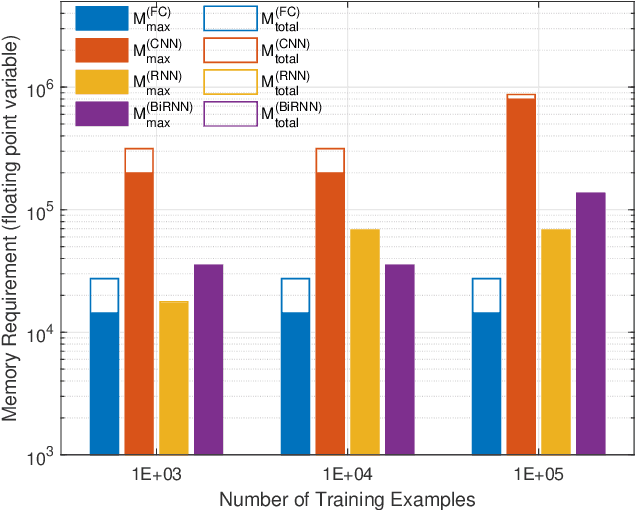
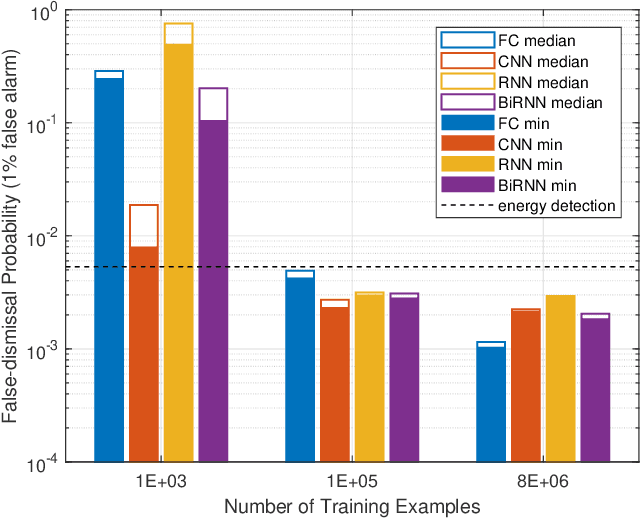
Abstract:Different neural network (NN) architectures have different advantages. Convolutional neural networks (CNNs) achieved enormous success in computer vision, while recurrent neural networks (RNNs) gained popularity in speech recognition. It is not known which type of NN architecture is the best fit for classification of communication signals. In this work, we compare the behavior of fully-connected NN (FC), CNN, RNN, and bi-directional RNN (BiRNN) in a spectrum sensing task. The four NN architectures are compared on their detection performance, requirement of training data, computational complexity, and memory requirement. Given abundant training data and computational and memory resources, CNN, RNN, and BiRNN are shown to achieve similar performance. The performance of FC is worse than that of the other three types, except in the case where computational complexity is stringently limited.
 Add to Chrome
Add to Chrome Add to Firefox
Add to Firefox Add to Edge
Add to Edge